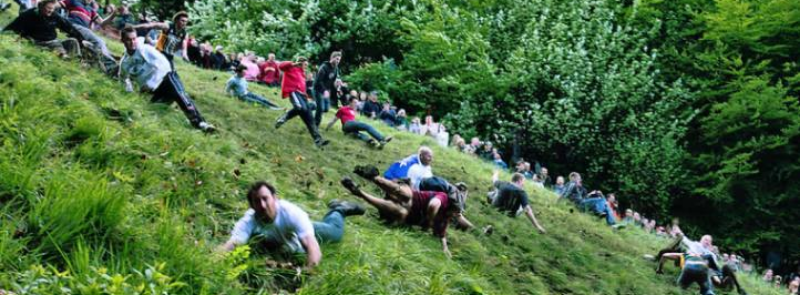
When It Occurs
Annually Last Monday of May
Official Website
Timeline
Days Passed (899)
# Hashtags
#GloucestershireCheeseRolling #CoopersHillCheeseRolling
The annual event known as the Gloucestershire Cheese Rolling, or the Cooper's Hill Cheese Rolling and Wake, occurs on the last Monday of May. Situated at Cooper's Hill near Gloucester, the event features five downhill races, each spaced 20 minutes apart. The origins of the event may be linked to the preservation of grazing rights or may have pagan roots.
History and Origins
The origins of the Gloucestershire Cheese Rolling event are somewhat obscure, with various theories about its beginning. Some believe it dates back hundreds of years, possibly to Roman times or pagan rituals celebrating fertility, where the rolling of the cheese represented the rolling of the sun. Others suggest it was a more local celebration linked to the grazing rights for the surrounding land.
One of the first recorded mentions of the event dates back to the early 19th century, although it is likely that it was already an established tradition by that point. Over time, the event evolved into a competitive race, with people traveling from near and far to take part in the exhilarating cheese chase.
The Event and How It Works
At the heart of the event is a round of Double Gloucester cheese, traditionally made by Mrs. Smart’s family of Churcham. The cheese, weighing approximately 8 to 9 pounds (3.5 to 4 kg), is released at the top of Cooper's Hill, a 200-yard-long hill with a steep, often treacherous slope. Contestants stand at the top of the hill, and when the cheese is set rolling, they chase after it in an attempt to catch it or at least be the first to reach the bottom of the hill.
- Start of the Race: A designated official, often the "Master of Ceremonies," releases the cheese. While the official goal is to catch the cheese, due to its speed — it can reach speeds of 70 mph (110 km/h) as it bounces and rolls — the first person to cross the finish line at the bottom of the hill wins the race.
- Nature of the Competition: Participants hurl themselves down the hill, which is not only steep but also uneven and covered in rough grass and hidden divots. Falls, tumbles, and injuries are common, adding to the spectacle.
Injuries and Safety Concerns
Given the extreme nature of the event, injuries are frequent. The steep gradient and the uneven surface make the descent extremely difficult to control, and many contestants often find themselves tumbling head over heels. Over the years, sprained ankles, broken bones, and various other injuries have become synonymous with the cheese rolling event.
In 2010, due to growing safety concerns and the overwhelming crowds that began to attend the event, the official organization of the race was halted. However, the event continues unofficially, driven by enthusiastic participants and spectators.
Rules and Categories
The event typically features multiple races, including separate categories for men and women. While the main race is the highlight, additional races may involve:
- Men’s race: The main event, where men compete to chase the cheese.
- Women’s race: Similarly, women compete in a race down the hill after a separate cheese.
- Children’s races: Occasionally, races for younger participants are organized on a flatter part of the hill or a less dangerous course.
There are no strict entry requirements, and anyone willing to brave the hill can take part. However, the unofficial nature of the event in recent years means it is usually a case of simply showing up and joining in.
The Cheese
The key to the event is the Double Gloucester cheese. It is a hard, smooth-textured cheese traditionally made from the milk of Gloucestershire cows. For the cheese rolling competition, the cheese is often encased in protective wooden sheeting to prevent it from breaking apart during its rapid descent down the hill.
In addition to the cheese used in the race, the winners often receive a wheel of cheese as their prize. Winning the Gloucestershire Cheese Rolling event is seen as a badge of honor, and many participants return year after year to defend their titles.
Spectators and Global Attention
The event has garnered significant global attention, with thousands of spectators flocking to Cooper's Hill each year. It is not just locals who participate; people from around the world come to either take part or watch the event unfold.
In recent years, international tourists and even foreign media outlets have covered the event. Its unique nature and the often comical scenes of participants careening down the hill have made it a viral sensation, with video footage of the races frequently shared across social media platforms.
Cancellation and Return
As mentioned, official support for the event was withdrawn in 2010 due to concerns about safety and the capacity of the infrastructure to handle the crowds. Despite this, the event has continued in an unofficial capacity, driven by its strong cultural significance and popularity.
In more recent years, organizers and the local community have found ways to manage the event more safely, ensuring that medical teams are on hand to treat injuries and directing traffic to avoid chaos on the narrow country roads around the hill.
Local Culture and Tradition
The Gloucestershire Cheese Rolling event is more than just a race; it is a reflection of the rich traditions and community spirit of the region. For locals, it is an annual celebration that brings people together and allows them to share in a fun, if slightly dangerous, tradition.
The race has also helped to promote Gloucestershire’s cheese-making heritage, specifically the production of Double Gloucester cheese. It has even inspired cheese festivals and tastings in the area, further boosting local tourism and the agricultural economy.
Conclusion
The Gloucestershire Cheese Rolling event is one of the most eccentric and beloved traditions in the UK. Combining adrenaline, humor, and local pride, the event showcases the unique blend of history and entertainment that makes British festivals so appealing. Despite its risks, it remains a cherished part of Gloucestershire’s cultural landscape and continues to attract thrill-seekers and curious onlookers from around the globe.


